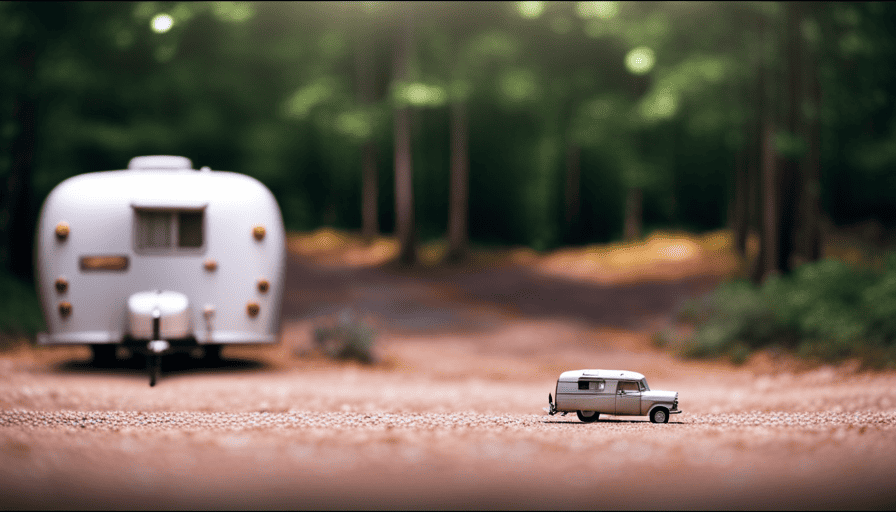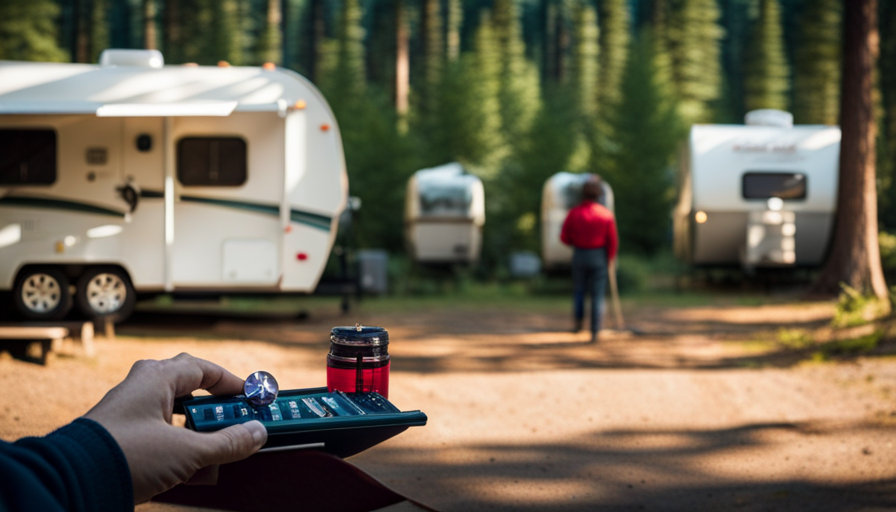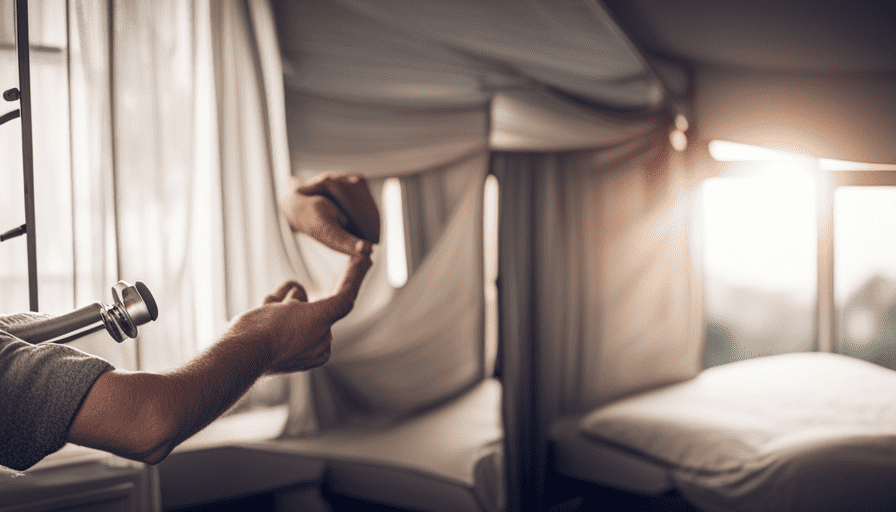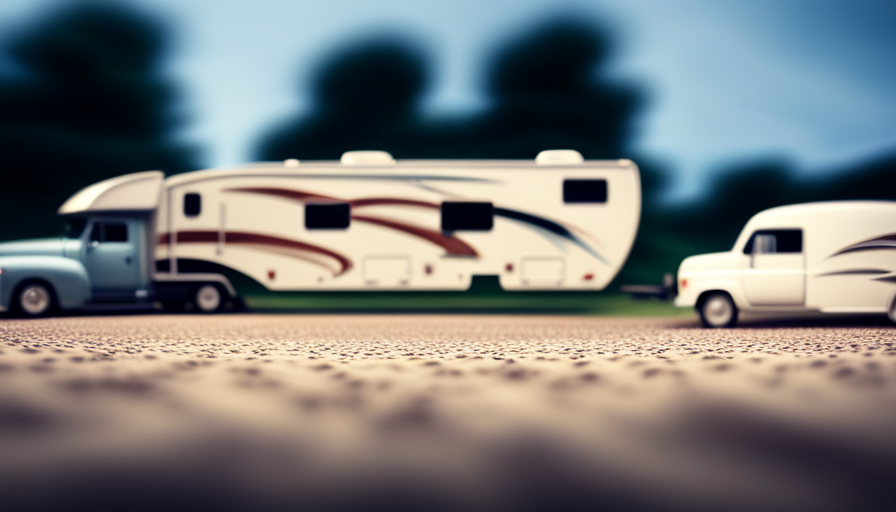When it comes to camping outdoors, having an uneven camper can ruin your sleep quality. Picture this: you’re in your cozy bed, but it feels like you’re on a rollercoaster, constantly rocking back and forth. Not only is this uncomfortable, but it can also be a safety hazard.
That’s why it’s crucial to know how to level your camper side to side.
In this article, I will guide you through the step-by-step process of leveling your camper like a pro. We’ll start by gathering the necessary tools, finding a suitable leveling spot, and using a leveling device to ensure precision. Then, I’ll show you how to adjust the leveling blocks or jacks to achieve the perfect level. We won’t stop there – I’ll also teach you how to make fine adjustments if needed and test the stability of your camper. Finally, I’ll share tips on securing your camper in place to guarantee a comfortable and safe camping experience.
So, let’s dive in and get your camper on the level ground it deserves!
Key Takeaways
- Importance of leveling camper for stability and weight distribution
- Tips for maintaining camper stability
- Techniques for adjusting leveling blocks or jacks
- Alternative leveling methods: chocking and lifting, adjustable stabilizers, shimming and stabilizing
Importance of Leveling Your Camper
You’ll want to make sure you level your camper properly to avoid any unexpected surprises or mishaps during your journey. The benefits of using a leveling system for your camper are numerous. First and foremost, it ensures that your camper is stable and secure, providing a comfortable environment for you and your fellow travelers. A level camper also helps to distribute weight evenly, preventing any potential damage to the structure or components.
Additionally, leveling your camper allows for proper functioning of appliances such as refrigerators and stoves, which rely on being on a level surface to operate efficiently.
To maintain camper stability, there are a few key tips to keep in mind. Firstly, it’s important to park your camper on a level surface whenever possible. This will make the leveling process much easier and more accurate. Secondly, you should utilize a leveling system that suits your camper’s specific needs. There are various options available, including manual leveling jacks, hydraulic systems, and electronic leveling systems. Choose the one that works best for you and your camper. Finally, it’s crucial to regularly inspect and maintain your leveling system to ensure it is functioning properly.
Now that you understand the benefits of using a leveling system and the tips for maintaining camper stability, let’s move on to the next section: gathering the necessary tools.
Gather the Necessary Tools
To make sure everything’s even, it’s crucial to gather all the essential tools for this task. When it comes to leveling a camper side to side, there are a few key items you’ll need.
Here are the tools I recommend:
-
Leveling blocks: Choosing the right leveling blocks is important to ensure stability and safety. Look for blocks that are durable, easy to stack, and can support the weight of your camper.
-
Leveling app or tool: Using a leveling app or tool can help you accurately determine how level your camper is. These apps use your smartphone’s sensors to measure the angle of your camper and provide real-time feedback.
-
Spirit level: A spirit level is a traditional tool that uses a bubble in a liquid-filled tube to indicate whether a surface is level. This can be useful as a backup or for double-checking the accuracy of your leveling app.
-
Wheel chocks: Wheel chocks are essential for preventing your camper from rolling while you level it. Make sure to choose chocks that are sturdy and can handle the weight of your camper.
-
Rubber mallet: A rubber mallet can come in handy for adjusting the height of your leveling blocks or tapping them into place.
Now that you have all the necessary tools, you can move on to finding a suitable leveling spot for your camper.
Find a Suitable Leveling Spot
Now that you’ve gathered all the necessary tools, it’s time to scout for the perfect spot to achieve that ideal balance for your camper. Finding a level surface is crucial for ensuring stability and preventing any unwanted movements while inside the camper.
Start by surveying the area around your campsite for a suitable spot. Look for a flat and even surface, preferably free from any rocks, roots, or other obstacles that could affect the stability of your camper.
Once you’ve identified a potential spot, it’s important to check the levelness of the area. This can be done using a leveling device, such as a bubble level or a smartphone app specifically designed for this purpose. Place the leveling device on the floor of your camper and adjust the position of the camper until the device shows that it is perfectly level.
Using a leveling device will ensure that your camper is balanced and stable, providing a comfortable and safe environment for you and your fellow campers.
With the leveling spot secured, you can now move on to the next step of using a leveling device to achieve that perfect balance for your camper.
Use a Leveling Device
Once you’ve found a suitable spot, it’s time to whip out a leveling device to ensure your camper is perfectly balanced. There are a few options for leveling devices, but two common ones are using a smartphone or a bubble level.
Using a smartphone:
- Download a leveling app from the app store. There are many free options available.
- Open the app and place your smartphone on a flat surface inside your camper.
- The app will display a digital level, showing you how much your camper is tilted from side to side.
- Adjust your camper’s position until the level reads zero, indicating it is perfectly level.
Using a bubble level:
- Place the bubble level on a countertop or other flat surface inside your camper.
- Adjust the camper’s position until the bubble is centered between the guide lines on the level.
- This indicates that your camper is level from side to side.
Now that you’ve successfully used a leveling device to ensure your camper is side to side level, it’s time to move on to the next step: adjusting the leveling blocks or jacks to achieve front-to-back levelness.
Adjust the Leveling Blocks or Jacks
After achieving a balanced position, it’s time to fine-tune the leveling blocks or jacks to ensure the camper is perfectly even from front to back.
When it comes to adjusting the leveling blocks or jacks, there are several techniques that can help you overcome leveling challenges.
Firstly, if the camper is leaning to one side, you can add or remove leveling blocks accordingly. Start by placing the blocks on the low side and gradually build up until the camper is level. To prevent the blocks from shifting, consider using a grip pad or mat underneath.
Secondly, if your camper is equipped with jacks, you can adjust them individually to achieve a level position. Begin by extending the jacks on the low side and gradually raise them until the camper is level. Keep in mind that it’s crucial to make small adjustments and check the levelness frequently to avoid overcorrection.
By using these adjustment techniques, you can overcome any leveling challenges and ensure your camper is perfectly leveled.
Now, let’s move on to the next step and check the levelness of your camper.
Check the Levelness of Your Camper
To ensure your camper is perfectly balanced, it’s essential to evaluate its levelness using a simple yet effective technique.
Checking the levelness of your camper is crucial because an unlevel camper can lead to various issues, such as discomfort inside the camper and potential damage to appliances and fixtures. One of the signs of an unlevel camper is doors and cabinets that don’t close properly. Additionally, you may notice that items inside the camper shift or slide when the camper is not level.
To check the levelness of your camper, start by using a bubble level or smartphone app specifically designed for this purpose. Place the level on a countertop or other flat surface inside the camper. Adjust the leveling blocks or jacks on the side that’s lower until the bubble is centered. Repeat this process for the other side of the camper.
If you find that your camper is unlevel, there are several ways to fix it. You can add or remove leveling blocks, adjust the jacks, or even park your camper on a more level surface if possible. Once you’ve achieved a level camper, you can make fine adjustments if needed to ensure perfect balance before continuing with your camping adventure.
Make Fine Adjustments if Needed
If your camper is slightly off balance, you can make minor adjustments to ensure a smooth and comfortable camping experience. Absolutely! You can use fine tuning techniques to level your camper side to side with precision. Here are some alternative leveling methods you can try:
-
Chock and lift: Place chocks on the low side of your camper’s wheels and gradually lift the high side using a leveling block or jack. Keep adjusting until your camper is level.
-
Adjustable stabilizers: If your camper has adjustable stabilizers, extend or retract them on the low side to achieve balance. Use a bubble level to guide your adjustments.
-
Shim and stabilize: Insert shims, such as wooden blocks or leveling pads, under the low side of your camper to raise it to the desired level. Then, stabilize the camper using stabilizer jacks.
By using these fine tuning techniques and alternative leveling methods, you can ensure that your camper is perfectly balanced for a comfortable camping experience. Once you have made the necessary adjustments, it’s time to test the stability of your camper and ensure it’s safe and secure for your adventure ahead.
Test the Stability of Your Camper
Once you’ve fine-tuned and adjusted your camper, step back and marvel at the rock-solid stability that’ll ensure a worry-free camping experience. Testing the stability of your camper is crucial to ensure a safe and comfortable trip.
To begin, start by walking around the camper and checking for any signs of movement or imbalance. Pay close attention to any areas that seem uneven or sagging. This’ll give you an initial idea of how well your camper is leveled side to side.
Next, it’s time to put your camper to the test. Walk inside and move around, simulating the activities you’d normally do while camping. Observe if there’s any rocking or shifting of the camper. If you notice any instability, it’s a sign that you need to make further adjustments.
To further assess the stability, try placing small objects, such as a ball or a cup of water, on various surfaces inside the camper. This’ll help you identify any areas that aren’t level. If the objects roll or spill, it means that the camper isn’t properly leveled side to side.
By testing the stability of your camper, you can address any issues before hitting the road. This ensures a safe and enjoyable camping experience.
In the next section, we’ll explore how to secure your camper in place without compromising its stability.
Secure Your Camper in Place
Ensure your camper remains as steady as a mountain peak by securely anchoring it in place. Stabilizing methods are crucial to preventing camper movement and ensuring a comfortable and safe camping experience.
Here are three effective ways to secure your camper:
-
Chock the wheels: Use wheel chocks on both sides of the camper to prevent it from rolling or shifting. These sturdy devices wedge against the tires, providing a solid grip and minimizing any chance of movement.
-
Stabilize with jacks: Deploying stabilizing jacks on each corner of the camper enhances its stability by creating a solid foundation. These jacks can be extended to provide additional support, eliminating any wobbling or shaking.
-
Use stabilizer bars: Installing stabilizer bars between the camper and the towing vehicle can significantly reduce lateral movement. These bars distribute the weight evenly, enhancing stability and minimizing swaying during transit.
By following these stabilizing methods, you can prevent unwanted movement and enjoy a comfortable and safe camping experience.
Now, let’s move on to the next section and explore how to level your camper for optimal comfort.
Enjoy a Comfortable and Safe Camping Experience
Make sure your camping experience is both comfortable and safe by following these essential tips. When it comes to enjoying a great camping adventure, one of the most important factors to consider is having a comfortable sleeping arrangement. After a long day of hiking and exploring, a good night’s sleep is crucial for recharging. Ensuring your camper is levelled side to side plays a significant role in achieving this comfort.
To level your camper, you can use various methods depending on the situation. One popular option is to use leveling blocks, which can be stacked or interlocked to create the desired height. Another approach is to use a leveling system, such as hydraulic jacks or stabilizer bars, which provide stability and balance. Whichever method you choose, it’s essential to refer to your camper’s manual for specific instructions.
In addition to a comfortable sleeping arrangement, it is also crucial to prioritize necessary safety precautions during your camping experience. This includes securing your camper in place to prevent any unwanted movement or accidents. Using wheel chocks, stabilizing jacks, and anchoring systems can help keep your camper steady and secure.
By following these tips and implementing the necessary safety precautions, you can enjoy a camping experience that is not only comfortable but also safe. Refer to the table below for a quick overview of the methods mentioned above:
| Method | Description | Benefits |
|---|---|---|
| Leveling Blocks | Stacked or interlocked blocks to create desired height | Easy to use, adjustable, lightweight |
| Leveling System | Hydraulic jacks or stabilizer bars for stability | Provides stability and balance |
| Anchoring System | Wheel chocks, stabilizing jacks, and anchors | Prevents unwanted movement or accidents |
Frequently Asked Questions
What are the benefits of leveling a camper side to side?
Leveling a camper side to side has several advantages and is of utmost importance. Firstly, it ensures stability and prevents the camper from tipping over. This is crucial for safety reasons.
Secondly, leveling the camper side to side promotes better sleeping conditions as it prevents uncomfortable slopes. Moreover, it helps in the proper functioning of appliances such as refrigerators and stoves, as they require a level surface to work efficiently.
Overall, leveling a camper side to side is essential for a safe and enjoyable camping experience.
How often should I level my camper?
I recommend checking the level of your camper regularly to ensure proper stability and functionality. It’s best practice to check the camper level before each use and periodically throughout your trip. This is especially important if you’re parked on uneven ground. Doing so will help prevent any potential issues with appliances, doors, or other components that could be affected by an unlevel camper. Maintaining a level camper is essential for a comfortable and safe camping experience.
Can I use any leveling device to level my camper?
Yes, you can use various leveling devices to level your camper. There are different leveling techniques available, including using leveling blocks, leveling ramps, or a leveling system.
Leveling blocks are versatile and can be stacked to achieve the desired height.
Leveling ramps provide a gradual incline for easy leveling. However, it’s important to consider the pros and cons of each device, such as stability, weight capacity, and ease of use, before choosing the most suitable option for your camper.
What can I do if I don’t have leveling blocks or jacks?
If you find yourself without leveling blocks or jacks, fear not! There are alternative methods for leveling a camper side to side.
One option is to use household items such as wooden planks or bricks to create a makeshift ramp. Simply place them under the wheels on the lower side of the camper until it’s level.
Another method is to park on a sloped surface, allowing gravity to naturally level the camper. Remember to always use caution and assess the stability of your setup.
How do I know if my camper is securely in place after leveling?
To check the stability of my camper, I look for specific signs that indicate if it’s properly leveled.
Firstly, I inspect the camper’s exterior for any noticeable tilting or leaning.
Next, I step inside and check if the doors and windows open and close smoothly without any resistance.
Additionally, I pay close attention to any unevenness in the floor or furniture.
These indicators help me determine if my camper is securely in place after leveling.
Conclusion
In conclusion, leveling your camper is crucial to ensure a comfortable and safe camping experience. By using the right tools and following the proper steps, you can easily level your camper side to side.
Imagine this scenario: You arrive at your campsite and discover that the terrain is uneven. With the knowledge gained from this article, you confidently set up your leveling blocks or jacks, making precise adjustments to achieve perfect stability.
As a result, you can relax inside your camper without feeling any uncomfortable tilting or shifting.










